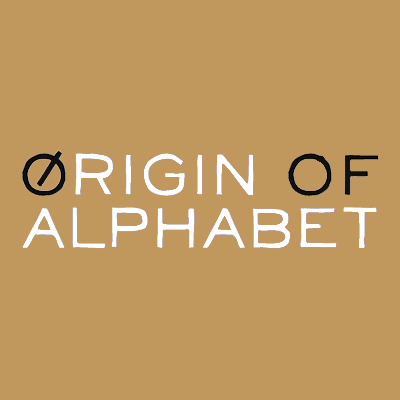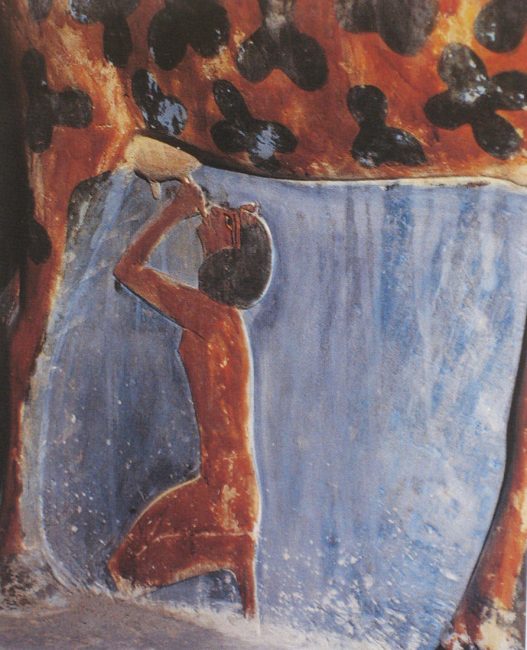Letter A: From Hawk to Ox

Top: Detail from King Djoser’s Step Pyramid of Saqqara,? approx. 2,600 B.C. Photographers: Matt & Erin Lyle Bottom:“Egyptian vulture” hieroglyph from Egyptian Grammar by Sir Alan Gardiner
The oldest Egyptian hieroglyphs to have been discovered were inscribed around 3200 BC, fully formed, with no clear antecedent. This is more than 5,000 years ago, yet we can still clearly recognize that the animal to the right is a kind of bird. Sir Alan Gardiner published his Egyptian Grammar in 1927 and put the “Egyptian vulture” at the top of the Egyptian alphabet. (This animal can be seen above as both a carving1 and, below it, as a hieroglyph recreated by Gardiner.) Gardiner lists 54 hieroglyphs as representing birds, and 55 as representing man. He lists only seven as representing women (not counting body parts). This correspondent between the number of individual bird hieroglyphs and the number of individual man hieroglyphs would imply that birds were held in as high a status as man by the Egyptians. The only thing higher were the gods and the king.
Birds were important to our ancestors because they can fly—an ability few animals have—and they brought pain from the sky. Birds have sharp beaks with which they attacked and even killed early humans. Agony and death were key concepts to primal man. This can be gleaned from the pointed shape of our letter “A” which evolved due to a reverence for sharp things.
The Egyptian vulture’s official name is Neophron percnopterus from the family “Accipitridae” and the order “Falconiformes.” This accipitridae, the precursor to our “A,” is interpreted by Egyptologists as an eagle or a vulture: It turns out they are nearly the same animal. “Vultures are classified into two groups: Old World vultures and New World vultures….Old World vultures belong to the family Accipitridae, which also includes eagles, buzzards, kites, and hawks.”2

The Egyptian vulture symbol signified that one should make a sound as if one were clearing one’s throat.
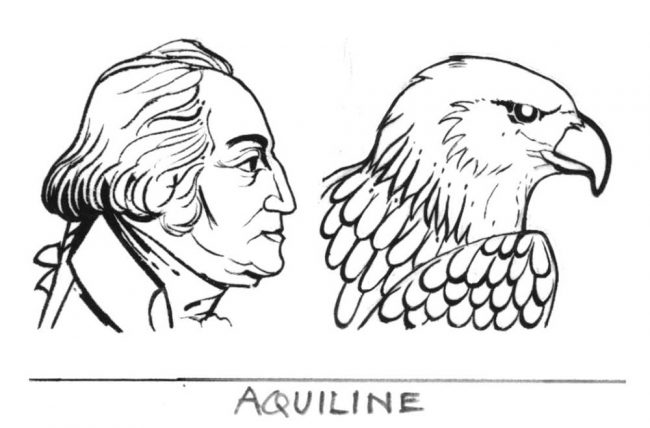
Examples of aquilinity: George Washington and an American bald eagle—the symbol of our nation. The aquiline nose was also referred to as the “Roman Nose, hook nose, or beak nose”1 found in people of Hebrew, African, and South American descent. “The aquiline nose… embodied the Pre-Raphaelite ideal of male beauty.”2 1 en.wikipedia.org/wiki/Aquiline_nose 2 http://commons.wikimedia.org/ wiki/File:Aquiline_(PSF).png
The word “hawk” could be the closest sound in English to what we recognize as a meaningful relationship between our first character “A” and how the Egyptian’s pronounced their first character. Drop the “h” when you say it so it sounds like “awk.” According to Florian Coulmas in the Blackwell Encyclopedia of Writing Systems, “The actual pronunciation of many Egyptian words remains unknown.”3 Coulmas reiterates Gardiner’s position, however, that “like Semitic languages, Egyptian has a word structure based on consonant roots.”4 One of these roots is the sound ak, which is the first syllable of the word “aquila.” “Aquila” means “eagle” in Latin (mythically the bird who belonged to Zeus5 , the king of the Greek gods), and it is also a constellation, as you can see below right, and “lies roughly at the celestial equator.”6 The Romans called this constellation a vulture. “Accipitridae,” the family classification of vultures, hawks, and eagles, means “diurnal birds of prey.”7 “Accip” is Latin and means “seize, accept”; “ac,” means “to, toward,” also in Latin, which is where you would go if you were about to seize something. This throaty ak sound is similar to what linguists call a glottal stop. It is a sound “made by bringing the vocal cords tightly together, blocking off the airstream and sealing the glottis, then releasing them suddenly. It occurs widely in the world’s languages, including…Arabic…represented in script by the letter alif [first position in the Arabic alphabet].”8

Aquila, the eagle constellation, is “mentioned by Eudoxus in the 4th century BC…[and] was also known as Vultur volans (the ying vulture) to the Romans,” according to Wikipedia.
When language began, words were probably not multi-syllabic. They most likely started with basic sounds. Pinker writes, “The first steps toward language were a mystery. This did not stop philosophers in the nineteenth century from offering fanciful speculations, such as that speech arose as imitation of animal sounds…linguists subsequently gave these speculation pejorative names like the bow-wow theory…”9 But every parent knows that verbal repetition is a part of a child’s arsenal of learning skills. It doesn’t seem a stretch to imagine that humans would imitate sounds heard in nature. We know words can be onomatopoeic: Bees. Cuckoo. Crow. Why would it be unusual for the first people to identify key animals by the sounds they made? “Hawk” sounds like a bird cry. The sound h is an extra exhale of air. Without that exhale, awk could be represented as ak. This sound can also have a broader, flatter a sound, as Americans say “aquiline,” which means “curved down like an eagle’s beak.”
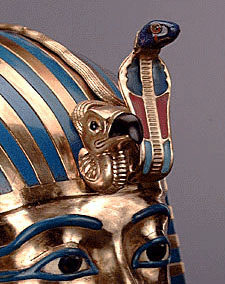
Tutankhamun’s crown with the vulture (family Accipitridae) and the cobra signifying royalty. Photo: http://www.civilization.ca/cmc/exhibitions/civil/egypt/images/ tut40b.jpg
If you say the first syllable of “aquiline,” “accipitridae,” and “accept,” you can hear that the first syllable “ac” shares a similar sound to “hawk.” Not only was this choking-up-a-fur-ball ak sound the first position in Arabic, but experts say it was present as the first sound in the Egyptian and Phoenician alphabets as well. Pardon my French, but to “hawk a loogie” is to cough something up out of one’s throat (or hack something up). “Hawking” is a kind of raucous calling that itinerant salesmen do, as in “hawking your wares.” “Rauc” means “hoarse” in Latin, which would be the condition of one’s throat after enough hawking. A possible ancestor of “hawk” and “raucous” is found in Hebrew in the form of “racham,”10
a carrion vulture. “Rok” is a “legendary bird of enormous size; borrowed from Arabic rukhkh, from Persian rukh.”11
The Persians conquered Egypt in 525 BC,12 so there was certainly the opportunity for language transference.
Could it be that the “AWK!” of a bird of prey stalking its quarry became incorporated by early man into the first character of the alphabet? This ak sound means “sharp point” in all Indo-European languages (see below left). Those early birds, with their sharp beaks and talons, imprinted the importance of pain upon man, and this behavior modification left its impression in the pointed shape of our capital “A” and in the “kuh” sound of the vowel-consonant cluster ak.
acanth-, ac-antha
ak Greek root, pointed part + anthos Greek, flower
In medicine, an acantha is a spiny,boy process of a vertebra. The pointy, prickly part of a plant is the thorn or spine. The root ak appears in all languages of the Indo-European family, where it means something with a sharp point. For example, in some English words derived from Latin, the ak– stem gives rise to acid, acetic, acne, acrid, acupuncture, acute and exacerbate.
On the front of the Tutankhamun’s crown there is a vulture head next to a cobra. In those days (Tutankhamun ruled 1136-1327 BC) one venerated something that could kill. You must put yourself in the mind of early man in order to understand that every day was painful and could bring death. The two-million-year-old Taung child, a three-year-old hominid Australopithecus found in 1924, is believed by scientists to have been eaten by crowned eagles….large, powerful raptors….capable of transporting the remains of primates in the estimated body-size range of juvenile early hominins.”14
That acuity could also account for the name “accipitridae.” “Cipit” means “head” in Latin. “Ac” would seem to mean sharpness of beak, talons, and eyes. These animals were called “sharp heads.” The Egyptian hieroglyph for “see” is two of these hawk-like animals plus a sickle and an eye. The italicized “3” is not a “3” but two backward “c”s on top of each other, and together they mean “glottal stop.” This Egyptian word for “see” would most likely have been pronounced “mawk-awk” or perhaps “moc-oc” is more correct considering that the “oc” in “ocular” is the same sound as “awk,” and “ocular” means “eye.”
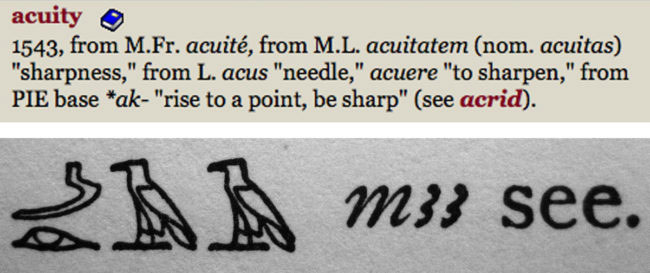
In Greek myth, Prometheus “stole fire from the gods for man—for which he was chained to a rock and tortured by an eagle,” seen on a sixth-century B.C. cup. Man and his Symbols, Carl Jung, page 114. Note where the eagle’s talons are.
The sickle plus the eye could be interpreted as “sharp eye” (the sickle being a sharp weapon and tool). According to Gardiner, “Egyptians…[had] exceptional powers of observation and keenness of vision. Intellectual and emotional qualities were ordinarily described by reference to the physical gestures or expressions by which they were accompanied, thus…‘cleverness’ is ‘sharpness of face (sight.)’”15 Sharpness of beak symbolized sharpness of sight. Two birds stood for two eyes. Our word “see” has two eye-like, lowercase, “e’s” in it, and the word “look” has two eye-like “o’s,” reminiscent of those two birds that stood for the double “oc” sound. The word “eye” also has two eye-like, lowercase “e”s and it even looks like a face as we saw in Chapter One, as does the Spanish word “ojo,” which means “eye.” Sign language for “see” is to point at one’s own two eyes and then at the object to be viewed (see left).

Bilaterally symmetrical letters with a vertical axis of reflection, above. Those with a horizontal axis of reflection, right.
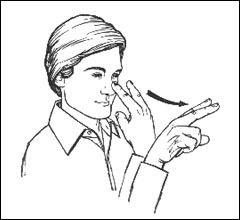
Sign language for the word “see.” Illustration credit: http:// library.thinkquest. org/10202/
People have two eyes because humans are bilaterally symmetrical. According to Pinker, this is because symmetry is attractive. “The molecules of life are asymmetrical….Making a body bilaterally
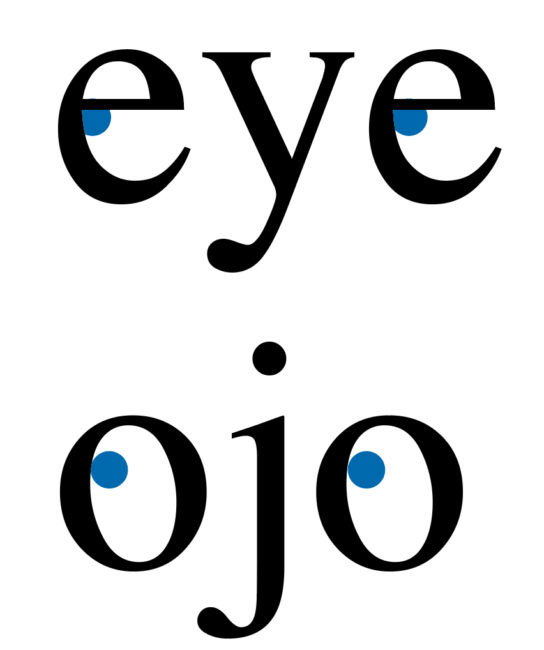
“Eye” in English and Spanish, with added pupils to illustrate how similar the words are to a face. The words are bilaterally symmetrical except for a deviation that happens in exactly the same place and the same direction: in the region of the “nose.”
symmetrical is difficult and expensive. Symmetry is so demanding that among animals with a symmetrical design, any disease or weakness can disrupt it. As a result, organisms…find symmetry sexy (a sign of a fit potential mate) and gross asymmetry a sign of deformity.”[not

e]The Language Instinct, Steven Pinker, page 308.[/note]
Being bilaterally symmetrical, we reflect the number two in our own bodies. Our two sides are mirror images split by a plane that goes vertically down the center of our nose and back of our head. Consequently we have two eyes, two ears, two nostrils, two hands, two legs, two breasts, and two ovaries or testicles. Eleven of our capital letters share this same vertical bilateral symmetry: A, H, I, M, O, T, U, V, W, X, and Y, and you could argue that seven of our lowercase letters do as well: i, l, o, t (handwritten), v, w, and x. Other capitals are horizontal mirror images (B, C, D, E, H—again, I—again, K, O—again, X—again). Sixteen out of 26 letters are clearly bilaterally symmetrical. And others, like “Z” and “N,” are bilaterally symmetrical with one rotation (which makes “Z” look like “Σ” and “N” look like an “M”).
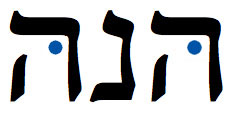
Top: “Behold” in Hebrew. Bottom: “Eye” in Korean, rotated 90° clockwise. (Pupils added for illustration.) Notice that the words are bilaterally symmetrical except for a deviation that happens in the same place and the same direction as in “eye” and “ojo.”
Early humans made our letters resemble the bilateral symmetry of animals. Not only that, we made some of our words look like faces on those animals. Lowercase “e-y-e” looks like two eyes and a nose. The Egyptians had an eye hieroglyph [![]() ], and we still carry that same symbol-concept in the shape of our lowercase “e.” The proof of this is not only the shape of “e,” but also the fact that the word “eye” resembles the bilateral symmetry of a face. The twoness of eyes, the unity of them astride a nose, is ingrained in our visualization of faces. Eyes come as a pair, even when you’re only talking about one of them. The word “eye” is not just a portrait of a face, but a caricature because the bilateral symmetry in the word “eye” is broken where the leg of the “y” turns left and implies a nose. The Egyptians portrayed images in their most informative angles, and one could argue that our word “eye” retains this same consideration at the expense of accurate perspective. Imparting information is superior to artistic considerations when it comes to language. The “j” in “ojo” also breaks the bilateral symmetry of that word in the same location and in the same direction. Not only do “eye and “ojo” share this phenomenon, but the same pattern of bilateral symmetry with a break to the left in the “nose” region can be seen in the Hebrew word “behold” and the Korean word “eye,” which has been rotated 90° clockwise. Four different languages, four face-words related to the concept of seeing. And “opo,” written ουσ, means “face” in Greek. Notice how similar this word looks to “oval” and “ova.” The ovoidal character of faces and eggs made their words share the same shapes.
], and we still carry that same symbol-concept in the shape of our lowercase “e.” The proof of this is not only the shape of “e,” but also the fact that the word “eye” resembles the bilateral symmetry of a face. The twoness of eyes, the unity of them astride a nose, is ingrained in our visualization of faces. Eyes come as a pair, even when you’re only talking about one of them. The word “eye” is not just a portrait of a face, but a caricature because the bilateral symmetry in the word “eye” is broken where the leg of the “y” turns left and implies a nose. The Egyptians portrayed images in their most informative angles, and one could argue that our word “eye” retains this same consideration at the expense of accurate perspective. Imparting information is superior to artistic considerations when it comes to language. The “j” in “ojo” also breaks the bilateral symmetry of that word in the same location and in the same direction. Not only do “eye and “ojo” share this phenomenon, but the same pattern of bilateral symmetry with a break to the left in the “nose” region can be seen in the Hebrew word “behold” and the Korean word “eye,” which has been rotated 90° clockwise. Four different languages, four face-words related to the concept of seeing. And “opo,” written ουσ, means “face” in Greek. Notice how similar this word looks to “oval” and “ova.” The ovoidal character of faces and eggs made their words share the same shapes.
The earliest words were the ones that were important to survival. Good eyes meant good aim, and the loss of an eye could result in hunger if a hunter missed his prey. A central Egyptian myth concerns Horus (a Jesus prototype often represented as a falcon) losing his eye in a fight with his uncle Set/Seth. “The eye must have been torn apart like the body of Osiris [his father], since Thoth is said to have put the pieces together again. The six parts of the wedjat eye (pupil, brow and so on) were used in the hieroglyphic script to write the fractions that made up the standard grain measure.”16 Through the magic of Djehuty/Thoth (an Egyptian god typically depicted as an ibis), Horus’ eye is restored. This “Eye of “Horus” was used as a protection on sarcophagi and tomb paintings—even a representation can be found on the back of an American dollar bill. “An abbreviated version of the Eye of Horus is still used by pharmacists as a symbol of their profession.”17 The wedjet/udjat or “Eye of Horus” could fly around, wandering the world. One wonders if the word “horizon” comes from the concept of the zone of Horus’s wandering eye.
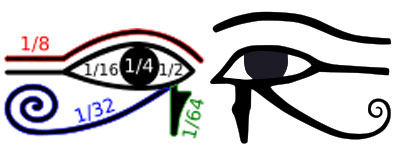
The Wedjat or the Eye of Horus, with associated measurements on the left (if you add the fractions, there is 1/64 missing; this was supposedly provided by Thoth’s magic). The wdjt is depicted as a sign of protection on the right. There is an eye topping a pyramid on the back of an American dollar bill. For protection perhaps?
Keen eyes and ears were key to survival. Visual acuity meant that when you aimed at an animal, you were more likely to hit it, and this increased the likelihood you would eat. Eating meant you were more likely to reproduce (because you lived one day longer), and the genes of the best hunters would continue to be expressed. Sharp eyes would flourish. Sharp eyes, which could theoretically see forever, might represent infinity. The far distance that good eyes can see would metaphorically stand in for vastness. Our sign for infinity—∞—looks a lot like two eyes. Before lined paper or typesetting, orientation was a lot looser, so “∞” is also “8,” just rotated 90°. This symbol ∞ also looks like the letters “oc” when they’ve been tightly kerned. The Latin word for “eight” is “octo.” There is that oc sound again. According to Stanislas Dehaene in his book Reading in the Brain, “Some [primate] neurons respond to two superimposed circles forming a figure eight.”18 Why wouldn’t they? ∞ is the shape of eyes, breasts, testicles (balls), and buttocks, all of which are sense organs or sex characteristics. Dehaene bases his info on Keiji Tanaka’s work, which demonstrated that “the monkey brain contains a patchwork of neurons dedicated to fragments of shapes…a ‘neuronal alphabet.’”19 Dehaene writes that other cortical sectors specialized in “stars, the simplified profile of a face, or the figure 8.”20
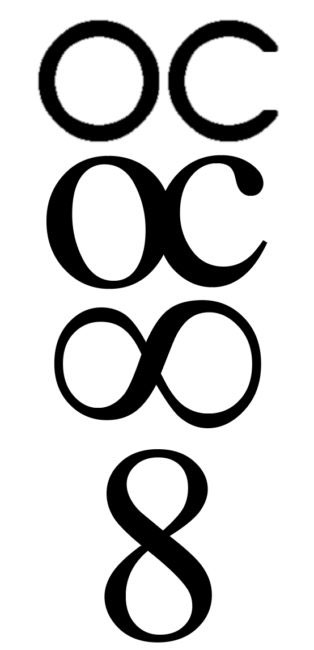
Related ideas? From the top: A closed and an opened circle. The letters “oc” touching. Our sign for “innity.” The number “8,” which is “octo” in Latin.
“O” is a closed shape and “C” is an open shape, both of which could represent a closed and opened eye (viewed in profile). The letter “C” is so identified with the eye that the word “see” is a homonym to the letter “C.” And “eye” is a homonym to “I”—our identity. The eye is the window to the soul. The eyes are often the only thing a man saw of a woman. Burquas attest to that today.
“The ancient Egyptian word for eye (irt) sounded like a word for ‘doing’ or ‘acting.’ This may be why the eyes of a deity are associated with divine power at its most interventional. Since the word irt was feminine in gender, divine eyes were personified as goddesses….Important goddesses such as Hathor, Bastet, and Mut can be called both the Eye of Atum and the Eye of Ra….The pupil of the Eye could be thought of as a womb in which gods and other beings were formed.”21
The eye as the womb, the circle as the center of being, is inherent in the juxtaposition of the three characters “ovo” because those letter shapes represent both an egg and a face. If you take the nose/vagine shape away, you have “oo.” The two-letter combo “oo” in “oophor” or “oocyte” means “egg.” A two-letter combo beginning with “o” can be found for many of the body parts. For example, “oc” is the beginning of “ocular.” “The dual “ob/ov” relates to “ovary” and birth (“obstetrician”). The two-letter “ot” is the first syllable for “otology,” which is the study of ear diseases. “Ot” and “aud” are very close in sound, and all the words related to hearing include one or the other, but more commonly the “aud” version seems to have substituted for “ot,” as can be seen in the following words: audio, audience, auditory, and audacious even; (allegedly “audacious” comes from “bold,” but as person who is usually considered too loud—and bold—I believe the word has roots in sound).
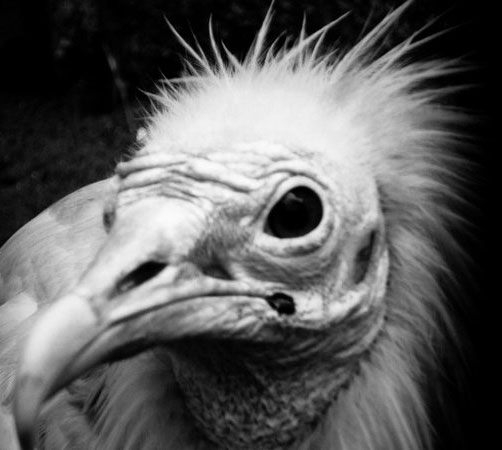
The Neophron percnopterus or Egyptian vulture uses “ingenuity in obtaining…food. Since the shells of ostrich eggs are too hard to break open by simply pecking at them, the vultures use rocks to assist them. According to reports by Jane Goodall from Tanzania, the vultures will search as far as 50 yards from the coveted egg in order to find a proper smashing tool.” (Source: http://www.pigeon.psy.tufts.edu/ psych26/birds.htm; photo: Egyptian_Vulture_Neophron_p__by_msaky.jpg.)
A word association trend is seen. When a characteristic is associated with another characteristic, the words share similar sounds, or similar shapes, or related meanings. “Eagle” is next to “eager” for a reason. Eagles are eager. The roots of “eager” are “vinegar” as in “pungent, acid” and also “ardent, fierce…keenly desirous or impatient.” From Latin acer “pungent, swift, strenuous, f. *ak- be sharp or pointed.”22 No doubt these animals are eager because they are very hungry. “The adult Egyptian Vulture usually measures 85 cm from the point of the beak to the extremity of the tail and 1.7m between the tips of the wings. It weighs about 2.1 kilograms…. The Egyptian Vulture feeds mainly off carrion. Due to its relatively small size [Small? This bird is almost three feet tall.] it needs to wait until other scavengers (such as the larger Gyps vultures and hyenas) finish their meal before it can start feeding….The Egyptian Vulture sometimes preys on small and slow mammals and reptiles, especially turtles. It lifts the turtle to high elevation and drops it on rocky surface, smashing its shell. The Egyptian Vulture is one of a few bird species that are known to use tools. It uses small stones to crack ostrich eggs by lifting a stone with its beak and hitting the egg in a strong swing of head and neck.”23
This tool-using bird, also known as a “Pharaoh’s Chicken,” is the perfect animal to start off the alphabet, because the alphabet is essentially tools—aids to early man: a sharp point, a portable fluid source, a stick. That’s A, B, C in a nutshell—they might not fit your category of tools, but they were the key items that allowed mankind to survive. Humans tend to revere the tools of survival. The ancient Egyptians certainly revered birds. The Egyptian god Horus was a falcon; eagles and vultures belong to the order Falconiformes. The name Horus still lives on. “A prehistoric family known only from fossils is the Horusornithidae [Horus birds].”24 Horus, the Egyptian’s god of divine kingship, has infiltrated our classification system as a term for very old birds. It turns out this is not the only ancient Egyptian in our language.
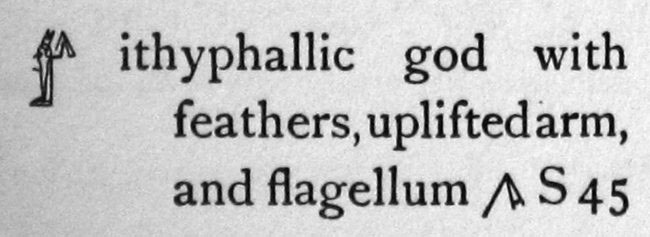
Koptos is where Min is found. The word “copulate” is very close to the sound of “Koptos” and the uplifted penis of Min suggests this was a common behavior there.
The evolution of Egyptian gods can be viewed analogously to the way words morph. According to the Oxford History of Ancient Egypt, “Each of this plethora of gods had his or her own role to play, but the situation is far from simple, because their roles changed through time, and gods could merge together so as to become all but indistinguishable from one another. Thus Horus, the falcon, shown with a sun disk, is often indistinguishable from the sun-god Ra…After Alexander’s conquest in 332 BC, Greek culture became implanted….A good example of this process of hellenization is the god Pan. He was equated with Amun-Min, the god of sexual reproduction, who had an important sanctuary at Koptos. The city is at the end of desert roads leading to the east. Amun-Min thus became the god of the east and was shown with an incense burner, perhaps symbolizing the spices and perfumes of the orient. From these beginnings, during the Roman period, Pan became the god of the Eastern Desert, the capricious guardian of the desert routes. He is shown not as the Pan of Greek mythology, but as the ithyphallic Min,25 his erection clearly inherited from his previous life.”26

The ancestors to our letter “A” from The Alphabet, A Key to the History of Mankind, by David Diringer, © 1948, page 213.
Gods morph, words evolve, patois propagates, but key concepts and sounds are the trails left by our ancestors. Fertility and power drove the Egyptians. The carvings and sculptures left in early tombs emphasize large phalluses, pendulous breasts, sharp weapons, horns, animals that can kill—all signs of a fascination with procreation and domination. We had to kill to survive. The desire for meat spurred our love of violence. “The acquisition of meat involves a considerable expenditure of effort. A potential quarry will always put up a spirited defense. Meat, therefore, is associated with danger. The hunter who consistently brought meat back displayed daring and courage, two qualities that females desired in a potential mate. Thus hunting possessed an erotic overtone: meat was an aphrodisiac.”27
Our genes evolved to make sex feel good because that way genes propagate. Desirable sex produces offspring. Offspring create a dynasty. An Egyptian dynasty is a kinship elevated to kingship: “individuals perpetuate their genes not only by producing offspring, but also by aiding relatives.”28
Procreation and domination go hand in hand. One’s tribe is one’s support system—a work force to be put toward conquering or acquiring bounty—all for the good of one’s gene pool.

Cuneiform tokens used to tally sheep and cattle. Contrast the symbol for sheep (see below, first line) with the symbol for women: The head is just in a different place. Could that cross represent something other than legs? Intersection perhaps? Could cattle look like an arrow because they have directionality when they plough and sharp horns that hurt like arrowheads?
Above you can see a chart of the progression of our currently very sharp and pointed-toward-the-heavens letter “A.” According to Denise Schmandt-Besserat in How Writing Came About,29
“It is now generally agreed that writing was invented in Mesopotamia, present-day Iraq, in the late fourth millennium B.C. and spread from there to Egypt, Elam, and the Indus Valley. It is also generally agreed that other scripts developed later, independently, in China and Mesoamerica.” Schmandt-Besserat determined, by looking at clay tokens used to keep track of commerce, that the token system was the precursor to cuneiform. How exactly, or if, cuneiform affected the hieroglyphs is speculative, and the same uncertainty in relationship exists between the hieroglyphs and the proto-alphabet. However, by crossing all languages, a pattern emerges, and connections between these systems become clearer. Whereas the Egyptians favored a bird for the beginning of their alphabet, the Phoenicians preferred an ox. You would expect priorities to change—there’s more meat, muscle, and milk on a bovine—but note that the sound we’ve been tracking is virtually the same: ac/ak/aqu/awk/oc/ox. This is the sound to follow in order to understand our “A.”
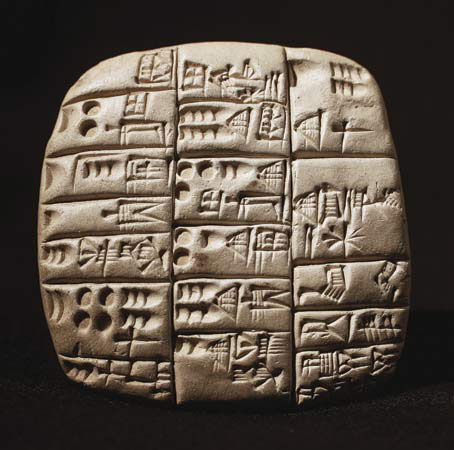
Cuneiform tablet featuring a tally of sheep and goats, from Tello, southern Iraq. © Gianni Dagli Orti/Corbis. Photo credit:http://media-2.web.britannica.com/ eb-media/93/84493-004-22864D43.jpg&imgrefurl
We spell it in a variety of ways, but Egyptians spelled the sound ak with a picture of hawk relative, and the Phoenicians spelled it with something like this: ![]() , which looks like an ox head—kind of. This head also looks like a lowercase, handwritten a—kind of. More than two hundred generations of handwriting until the printing press would alter shapes a little I imagine, but—you notice—not a lot.
, which looks like an ox head—kind of. This head also looks like a lowercase, handwritten a—kind of. More than two hundred generations of handwriting until the printing press would alter shapes a little I imagine, but—you notice—not a lot.

“A special relationship” between human and cattle….Hathor adorned with an “Eye of Horus.” A detail for the Final Vignette in the book of the Dead of Ani, the scribe. From The Art of Ancient Egypt, David Sandison, page 63.
That sharp beak of an accipitridae had been replaced by those sharp horns of the ox in the ranking of the evolving early humans. Sharpness is a concept that accompanies pain. “OG!” is the classic caveman cry. The sound of ignorance, of Neanderthals, of big galoots waving brute force weapons like rocks or sticks. The he-man yell was no doubt some variation of “OG!,” intoned through the generations that made up the childhood of human life. “Augggh!” is what comic strip characters yell when they’ve been hurt. (I just read this in “Pearls Before Swine,” so I know.) Could the “AWK!” or “OX!” that was grunted by the alpha male—who identified himself with powerful beasts and probably had to hawk a lot because he was missing teeth and game was chewy—could that “AWK!” have been the first male identity, the primordial cry of the alpha male establishing his dominance with the threat of violence? For a very long time, the first sound in the list of important sounds of primal man was something close to “OX!” and the shapes that stood for this sound are the ancestors of both our upper- and lowercase “A.”
How did an eagle from the Egyptians change into an ox by the time it got to the Phoenicians? Ox and eagles were ubiquitous in the areas where writing originated. “The earliest undisputed evidence for domesticated cattle in Egypt is from …5000 BC….Yet, as early as even 12,500 BC, there existed a special relationship between human and cattle in the Nile Valley. In Egyptian Nubia at Tushka, the horn cores of wild cattle were discovered directly over two human burials, and a horn core was also found near the skull of a third burial. They appear to have been grave markers.”30

Venus de Lausell, an approximately 25,000-year-old carving of a women with a notched horn found in France. (Photo: commons.wikimedia.org.)
The Venus de Lausell, found in France, is “a 1.5 foot high limestone bas-relief of a nude female figure, painted with red ochre. It is related to Gravettian Upper Paleolithic culture (approximately 25,000 years old).”31 The 13 notches on the horn the woman holds near her face (which is in profile) are thought to have been a kind of record keeping. (Moons? Menstrual cycles? Good guesses, but no one knows). Horns offered a larger surface than beaks did. Besides their obvious use as weapons, horns could also be used as writing surfaces, drinking vessels, tools for digging, accessories for costumes or rituals, and even as instruments. I don’t think it’s a stretch to imagine the horn as a sexual aid or torture device. A common depiction of the horn was as a cornucopia: the horn of plenty. A horn signified bounty, copiousness. In French corné means “horny,” which means “horn-like,” but it’s hard to avoid the sexual connotation as well. Corné is a word that sounds like meat: carné, which is what you’d expose if you were gored by a horn. The sharpness, and consequently the pain, associated with the ox’s horns and the eagle’s beak solidified the linkage of their “OX/AQU” sound.
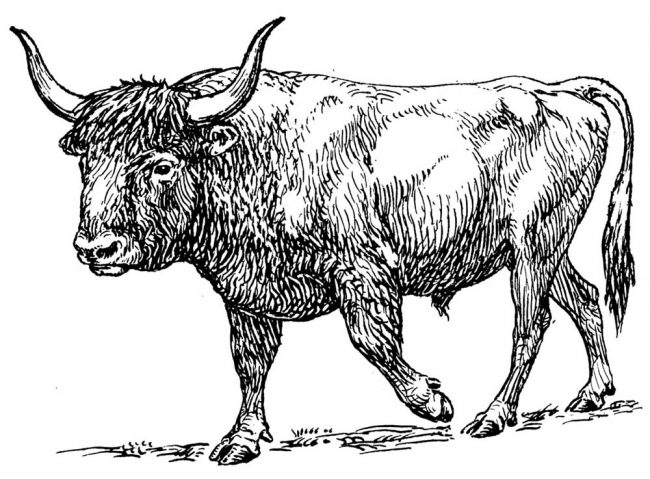
Bos primigenius “Aurochs” (Photo: commons.wikimedia.org.)
Birds of prey were symbolically important to the early humans (their ability to fly and their nurturing skills impressed the Egyptians), but the oxen’s advantages made the bovine species supersede the aquiline as man’s best icon. Just in surface area alone, oxen could offer so much more: more meat, more power, and that power could be harnessed. Oxen’s potential energy ultimately resulted in agriculture. Plus, let’s not forget the ox’s better half—the cow who ultimately provided the milk—because it was the cow that solidified the ox as the ancestor to our “A.” The ability to tether and control livestock was significant in the development of man. Bos primigenius taurus, the name given to the wild Aurochs, is the same species as the Bos taurus, which is domesticated cattle. The aurochs were about 130% bigger than contemporary cows (one skeleton is almost six feet tall, and they were found throughout Europe, parts of Asia, and North Africa. “Bull aurochs…had longer horns that pointed forwards rather than swept out to the side. Cave paintings from various sites across southwest Europe, such as Lascaux in France, tell us that aurochs bulls were mostly black…whilst cows and calves were red in colour…. At its maximum extent, the aurochs was found in southern and central Europe, North Africa, parts of the Middle East and across Asia as least as far east as India….”
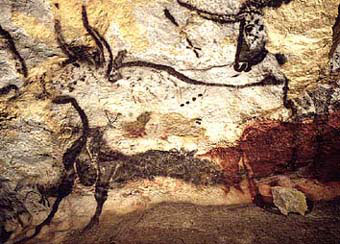
Lascaux cave paintings, circa 17,000 years ago. (Photo credit: commons.wikimedia.org.)
“Ox” as the ancestor of our capital “A” is not hard to imagine. The animals were so ubiquitous, early man saw Taurus the Bull in the stars—part of the horoscope: the scope of Horus. The ox has been with us for a long time. It ploughed the fields. It provided sustenance. According to Nature, “The domestication of cattle, sheep and goats had already taken place in the Near East by the eighth millennium BC. Although there would have been considerable economic and nutritional gains from using these animals for their milk and other products from living animals—that is, traction and wool—the first clear evidence for these appears much later, from the late fifth and fourth millennia BC…..The milking of ruminant animals was clearly practised intensively in the sixth and seventh milliennia BC in northwestern Anatolia.”32 That’s 9,000 years ago.
“The milking of ruminant animals was clearly practised intensively in the sixth and seventh milliennia BC.” That’s 9,000 years ago.
Hathor suckling Amenhotep II, which was proof of divine kingship detail of painted sculpture,18th dynasty, Egyptian Museum, Cairo. Photo credit: www.dondougan.com
Early man’s reverence for milk manifested itself as a reverence for the package in which milk came. Egyptians elevated cows, bulls, sheep, goats, teats, and breasts in general. There were several cow goddesses, but they were all eclipsed by Hathor. “Hathor was a cow-goddess, depicted as a cow, a cow-headed woman, or a woman with a cow’s horns and ears. She was known as the Golden One, Lady of Love, Music and Intoxication….She was a symbol of motherhood and fertility, the suckler of the king, and the patron-goddess of unmarried women. Also, with the help of the dwarf-like god Bes, she protected women in childbirth.
“As Hathor-of-the-West she was a goddess of the dead. She was also patron-goddess of the mining region in Sinai.”33
Funny that a cow would be the patron-goddess of miners. Could the intoxication of milk have spawned the alphabet? Hmm…I don’t think milk could do it alone.
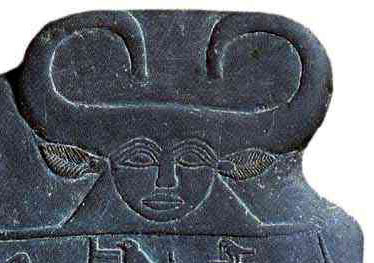
The original cowgirl: Hathor the bovine symbol of fertility. Detail of Narmer palette, circa 3,200 BC, show- ing usual depiction of the cow goddess with large horns, cow ears, and human face. From www.narmer.pl/main/pal- nar_en.htm
“The site of Serabit el-Khadim featured a temple of Hathor, ‘Mistress of Turquoise,’ reflecting her importance as Egyptian tutelary goddess of desert regions. Founded in the Middle Kingdom period, the Hathor sanctuary was expanded and maintained into the New Kingdom.”34 “Her name means House of Horus, and she was closely associated with Horus, as his wife and as mother of his son, Hor-sma-tawy. The Greeks identified her with Aphrodite, goddess of love.”35
Goddess of love as only a cow knows how to be. A older cow goddess was named Bat, and it would seem that “Bat” evolved into “Hathor” because that “B” means sustenance in the form of milk. However, “H” is a sign of elevation (think “heaven” and “high”), so once Bat became the “home” of Horus (if you know what I mean), Hathor’s name elongated to show this elevated status and specific role.
Hathor may have been the cow goddess, but it’s the ox that became our “A.” The scribes and sculptors who left a record revered the cow, but, being mostly male, they identified with the ox. An ox was an asset. It was an emblem of power, a beast of burden. An ox was an animal on which a guy could hang a metaphor. “Strong as an ox” is a cliché for a reason. The deep “ah!” vowel sound plus the glottal stop that sounds like a “K” or a hard “C” spoken by the alpha male may have meant, “Me who is the strongest and has the power, and I’m making this noise to refer to myself because the word ‘I’ has not yet come into existence.”
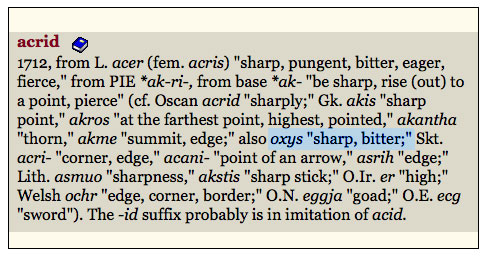
Ak and ox have the same meaning: sharp. They are two spellings of nearly the same sound/same concept. This happens often in language. Photo credit: etymologyonline.com. I’ve added the blue.
This Ox character didn’t need to say a lot to make his needs known. He had a stick for that (what turned into our “C,” “G,” “L”). These were monosyllabic people in the beginning of humanity. They didn’t need many words because there weren’t a lot of things that needed to be said. There were scary things and nice things. Things that hurt and things that felt good. Dominance was established by strength, and the threat of violence was communicated by the father of the tribe with a deep, angry, “AWK!” cry. The alpha male is the man at the top. Many words that relate to the top have that same deep vowel “ah” plus glottal stop k sound: acropolis, akron, even Strong’s #188 in the Greek lexicon—akmen—which is pronounced “ak-mane’” and means “1. a point, 2. extremity, climax, acme, highest degree, 3. the present time.” The word comes from “ake (a point).”
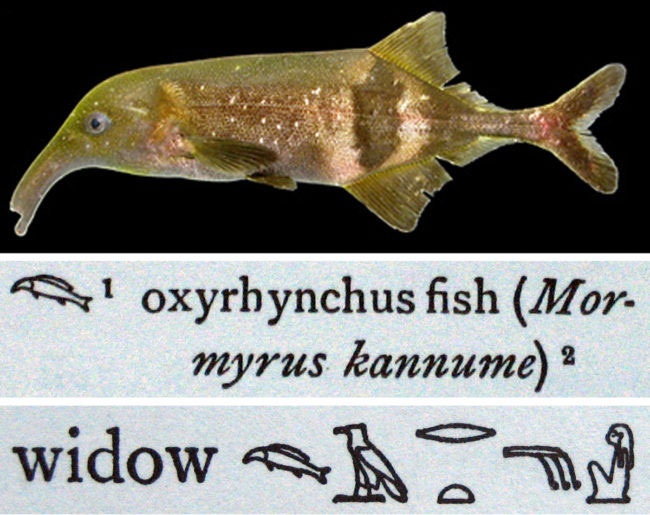
Top: A mormyrid.
Middle: Hieroglyph of the sharp-nosed fish.
Bottom: Hieroglyph for widow which includes penis-eating fish, the implication being that a widow is a woman without a penis.
In Greek, that sharp point had two spellings: “ak and “ox.”36 When you spell with pictures—which don’t always translate to cultures correctly—vowels change, but the concept of pain remains the same. The word “oxygen” is from the Greek oxys, which means “acid” or “sharp” and gene, which means “‘producer.”37 Oxalis is a flower with “sharp-tasting leaves.”38 “Oxymoron” means “sharp-stupid.” “Oxyphonia” means “an abnormally sharp quality of the voice.” “Oxyrhine” means “sharp, pointed nose.” Oxyrhincus is a town “named after a species of fish in the Nile River that was also important in Egyptian mythology. According to ancient Egyptian legend, a fish is said to have eaten the penis of Osiris, though it is not known exactly which species of fish this was. One possibility is a…freshwater fish, called the mormyrid, which have distinctive downturned snouts or barbels. A figurine from Oxyrhynchus of a fish has many attributes typical of mormyrids: a long anal fin, a small caudal fin, widely spaced pelvic and pectoral fins, and of course the downturned snout.”39 Above is a mormyrid. Note that the fish shares the pointed curvature with the bird beaks and oxen horns.40 The Egyptian hieroglyph for “widow” also includes this fish, which implies that a widow is a woman who has lost her penis. This fish is also in the Egyptian word for “corpse.”
In Greek, “eight” was written as: ![]() . This is pronounced “oct-toe” (accent on the “toe”: you can hear it at www.searchgodsword.com, Strong’s # 3638). Note how much those first two characters look like “ox.” Ox were often yoked as a team of two, which would yield eight hooves (note that the fourth character looks like hoof; the “t” preceding it could possibly represent a yoke). It’s interesting to speculate on the relationship of toes to hooves, but what is more clear is that early man valued animals that displayed curvature. Curves, or arcs, are naturally strong because “stress is distributed equally along the arc instead of concentrating at any one point.”41 Beaks, horns, and snouts are typically curved. Horns are made out of keratin, which is a coiled coil. These coiled coils are dense because they can pack tightly.42 “Keratins are a family of fibrous structural proteins; tough and insoluble, they form the hard but unmineralized structures found in reptiles, birds, amphibians, and mammals. They are rivalled as biological materials in toughness only by chitin [main component of insects and crustaceans].”43
. This is pronounced “oct-toe” (accent on the “toe”: you can hear it at www.searchgodsword.com, Strong’s # 3638). Note how much those first two characters look like “ox.” Ox were often yoked as a team of two, which would yield eight hooves (note that the fourth character looks like hoof; the “t” preceding it could possibly represent a yoke). It’s interesting to speculate on the relationship of toes to hooves, but what is more clear is that early man valued animals that displayed curvature. Curves, or arcs, are naturally strong because “stress is distributed equally along the arc instead of concentrating at any one point.”41 Beaks, horns, and snouts are typically curved. Horns are made out of keratin, which is a coiled coil. These coiled coils are dense because they can pack tightly.42 “Keratins are a family of fibrous structural proteins; tough and insoluble, they form the hard but unmineralized structures found in reptiles, birds, amphibians, and mammals. They are rivalled as biological materials in toughness only by chitin [main component of insects and crustaceans].”43

Aquiline. Ox horn. Oxyrhynchus. They all share the ak sound AND the sharp curvature that one associates with —wait for it—the arc. Awk/ark—not much of a stretch. Especially since Noah’s Ark is one of the oldest legends. Boats were big in Egypt. Lots of kings were buried with them. “Twelve ‘boat burials’ were discovered…to the south east of Djer’s funerary enclosure [first dynasty, 3,000-2,890 BC]….These burials consist of pits that contained wooden hulls of boats 18-21 m. long…Smaller boat burials have been found associated with the Early Dynastic tombs of high officials at Saqqara and Helwan….The purpose of these boat burials is unknown….The examples at Abydos are the earliest evidence of an association between boats and the royal mortuary cult.”44
These boats were also known as “barks” or “barques,” which is an arc that gets sustenance from that “B” fronting it: barks were boats of the kings.
Could “awk” have become “arc”? Look at the shape of our “C.” It’s an arc itself. The “C” and “G” shapes evolved from a throwing stick that was curved or bent like a boomerang. Curvature tends to make things rotate, so a curved stick was more likely to return to you than a straight one.
Arrows arc. Arcarius is the Greek word for “archer.” An arrow flies in the sky and it’s got a sharp tip. A hawk soars through the sky and it’s got a sharp beak. To go from “hawk” to “arc” is not unreasonable when one looks at a dictionary of Greek and Latin roots and sees the relationship of similarly sounding words. “Arc” to “orc” is a slight shift of vowel, and no surprise that orchids were named because the shape of their bulbs look like testicles, which we know has the slang term of “balls.”
“Orc” has the same roots as “ogre” (an entity famous for inflicting pain who is typically a giant and over-arches humans) and is ultimately from the Latin word for the god of hell: Orcus. I’m guessing the jaws of Orcus were significant. “From Orcus’ association with death and the underworld, his name came to be used for demons and other underworld monsters, particularly in Italian where orco refers to a kind of monster found in fairy-tales that feeds on human flesh. The French word ogre (appearing first in Charles Perrault’s fairy-tales) may have come from variant forms of this word….An early example of an orco appears in 1585 in Ludovico Ariosto’s Orlando Furioso, as a bestial, blind, tusk-faced monster inspired by the Cyclops of the Odyssey; this orco should not be confused with the orca, a sea-monster also appearing in Ariosto.”45
Orcas are both mammals of the sea, and they arc out of the water on occasion. Considering other “orc” words that arc, an orchestra is configured to be in the shape of a semi-circle. To orchestrate something is to be the over-arching controller, like a monarch, a metaphor meaning “king” but implying that the king is the “one arch.” An arch is an arc elevated to architecture: arc with texture—stone or wood realizing the higher beauty of mathematics. Even the word “arachnid,” whose first two syllables “arach” is a stretched out version of the “awk/arc” progression, also shares conceptual similarity in that an arachnid is an octopod, meaning it has eight legs, and the shape of a spider is typically several arcs, as its legs support its body. According to Dehaene, “When response from several neurons tuned to letters are combined, we arrive at neurons sensitive to letter conjunctions.”46
Dehaene refers to these neurons as “bigrams.” He writes (and the italics are mine), “The receptive field of these letter detectors are spread over part of the retina, and they have no way of knowing whether one or two other letters have slipped in. Thus bigram neurons should respond to a given letter pair even it is it spatially extended…possibly separated by one or two irrelevant letters.”47 Therefore “arc” and “arach” would seem very similar to the brain.
A slight variation of this vowel-consonant cluster “arach” produces Icarus, who donned eagle’s wings attached with wax (which comes from the word cera as in “ceramics,” something moldable; contrast this with keratin—something that molds) but flew too close to the sun and so the wings melted, and Icarus hit the ground hard.
Icarus falls from the hubris of flying too high. Daedulus, his father, watches as his son careens toward earth. Photo credit: http://monroelab.net/blog/wp-content/uploads/2006/03/Daedalus-and-icarus.jpg. Artist unknown. This picture is on a lot of sites, but sadly, no one credits the artist. Any ideas?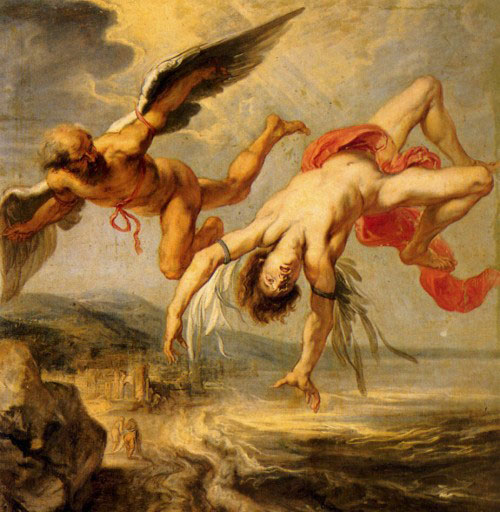
The “kuh” in “Icarus” is the part of the word where he hits the ground hard.
You may have noticed by now that ak was one sound to the Egyptians, but to us it is two sounds: “awe” and “kuh.” “Awe” is a reverential sound—“Ah!”—a sound of enlightenment: why ‘A” points to the heavens, up where birds fly. The “kuh” sound in ak is the sharp point; it is the part of the word that signifies pain. You can still see the effects of “kuh” on the top of the “A,” a vestigial horn (or corn or thorn—a hard, pointed thing) that says, “Respect this letter, bitch.” (Is that too rough? To explore words, you have to be able to use them effectively and not shy away from sketchy phrases. Trust me on this. The sketchy phrases are one of the places where you find truth in language.)
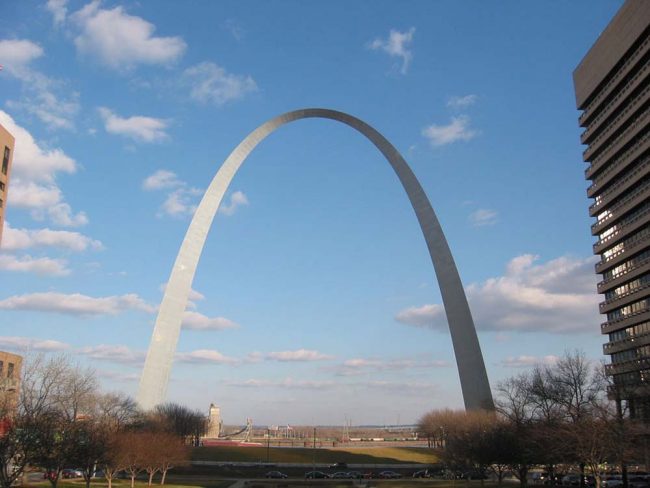
St. Louis’ arch. An arch is a segment of a circle extruded into three dimensions.

Letters morph to form each other:“A” to “K”; “K” to “A.”
The alphabet is programming code of the man kind. Leftover concepts from an earlier era still inhabit the letter forms and the words of our language like wisdom teeth or the appendix or supernumerary nipples (more on that later…). That vestigial horn is also seen in the midpoint of the “K.” On page 32, you can see that some of the early symbols for our first character “A” looked a lot like “K.” The reverence given to kings is because of the pain they have the power to inflict. This ox character was the original king, and he could cut you. “Kuh” is the sound of cutting. The shape of “K” retains a similarity to that of “A’s” (see above right: only one rotation and a realignment of the “V” and the “I” shapes that make up “A” and “K” is all it takes to synchronize the two letters). “K” also retains the second sound of ak: the “kuh.” The letter “C,” “K’s” occasional aural twin, signifies the sound of “kuh” under certain circumstances as well. Instead of demonstrating this sound with a sharp point, the “C” is like a circle that has been cut. A cut circle is an arc. “C” is an arc rotated 90° counterclockwise from how we normally view arcs: as arches that arc over us. An arch is an arc that has been extruded into three dimensions.
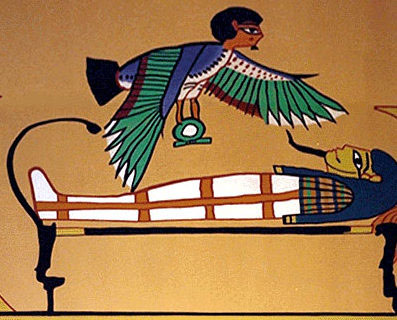
Ba, the angel-like creature with the human head and bird body, functioned as the Egyptian’s “soul.” According to Gardiner, this word is really pronounced “bawk” similar to a bird squawk. Perhaps this is the sound the soul makes as it leaves the body (Picture credit: the Canadian Museum of Civilization. http://www.civilization.ca/cmc/exhibitions/civil/ egypt/images/reli19b.jpg.
The arch is the pinnacle of design. It points to the heavens, up where the birds and angels fly. The afterlife was very important to Egyptians. They envisioned the first angels: Ba was a bird with a human head that left the soul and flew away when a person died. 48

Hieroglyphs upper right from Gardiner.
Egyptians believed there were five parts of the soul: the ka, the ba, the akh (plus the ren and the shuet). If you reverse the ka, the ba, and the akh, you get: akh, ba, ka, which sounds a lot like A, B, C, or at least the sounds associated with those letters. The Egyptians thought that the Ba and the Ka (the corporeal body) needed to unite so that the dead person wouldn’t die again. “When someone died their Ka split into two, the Akh and the Ba. The Akh, in the form of a bird, flew to the afterlife where it turned back into the Ka….The hieroglyph representing the Akh is the sign of the crested ibis (Geronticus Eremita)….The word ‘Akh’ also means ‘to shine,’ it is from the term ‘Radiant light.’ The transformation into the Akh is symbolized by the adding of a crest to the normal Ba bird to make it an Akh bird….The Akh is the result of the Ka and Ba being reunited in the after life; once reunited the Akh is unchanged for all eternity. The Akh was the form in which the deceased occupied the afterlife….The deceased would become a part of the Akh-Akh (Starry sky).”49

The four canopic jars held the entrails of the dead and were topped by the heads of the four sons of Horus, each holding a different organ and representing one of the four directions—north, south, east, and west.50 The “ka” (or “ca” as in “canopic”) is often defined as “spirit” but the ancient Egyptians left food and drink for the ka so “carnal” or “carnate” is probably closer—it’s ultimately related to meat: carne. According to Gardiner, “ka” was really pronounced with a glottal stop (that backwards “3” which is really double “C’s”—almost as if you were supposed to hit that “C,” which is really a k sound, doubly hard). This means one’s “ka” was really one’s “kock” in old Egyptian. The sign for “cock” was the upraised arms, whether in salutation or more of a “I give up” gesture is unknown, not that they’re mutually exclusive. That the concept of “spirit, soul, double” would be pronounced as “cock” in Egyptian seems reasonable. Even today that word stands for a good part of the male identity. The “double” or one’s doppelganger seems to be an accurate depiction of “cock” because this double needed to eat and partake in life, including dancing girls (see above).
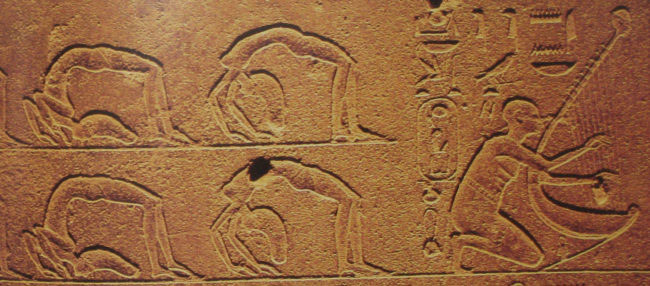
Dancing girls in the Red Chapel erected by Hatshepsut at Karnak. Photo credit: The hieroglyphs of ancient Egypt, Aidan Dodson, page 81.
Back then, when a “cock” had been separated from its “bock,” it often involved pain. Acute pain is defined as “severe and quick.”51
“Acutus” in Latin means “abrasive, lurid, sharp, dangerous.”52 “Acutus” begins with that by now well-known ak sound, the auditory palindrome of “ka.” You could abrade yourself on an acute angle. The word “angle” is very close to “angel.” An arrowhead is an acute angle that would cause one to see angels. According to the Oxford History of Egypt, arrowheads are seen in the pre-Egyptian culture of Bashendi around sometime between 5,400-4,900 BC,53 though arrowheads 60,000 years old have been found.54 Three-pronged harpoons are “typical” at Merimda at the edge of the Western Nile Delta.55

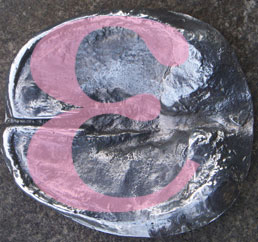
Epsilon has the same shape as a cloven hoof. The beauty of the internet is that you can find the character epsilon and then you can superimpose that over the picture of a preserved cow hoof (from www. pets-paws.com/ orderform. htm). This was probably the hoof of someone’s pet cow, a relationship which isn’t so much of a stretch anymore…
The sharp horns on an oxen could be another cause for seeing angels, and the Greeks saw angels as messengers who ordered around mankind in the same way that oxen were ordered around by man. “Aggelos” ἄγγελος (pronounced an-gee-los) is “angel” in Greek and “agele” ἀγέλη were oxen. “Age” ἄγω (ah-gay) is to lead someone, which angels and oxen both do. “Angle” and “ankle” are very close in our language, both in sound and in meaning (the ankle makes a right angle where it turns from leg to foot). “Agkale” ἀγκάλη means the bend or “inner angle” of an arm. When you consider that the elbow (“L-bow) and ankle are both angles of the body, it would seem that sharp things—like ankles, angles, and elbows—and heavenly things—like angels, which you would see after you encountered such a sharp thing—are similarly named.
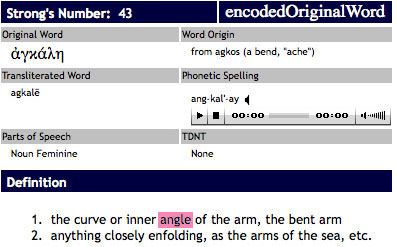
Early man understood the deadly power of sharpness. Pain and death were as unsettling then as they are now. The building of the pyramids and the carving of hieroglyphs helped the Egyptians deal with the enormity of death; they saw documentation as a way to ensure that the lives of their high status individuals did not go unnoticed by the gods, which turn out to be us. Egyptologists and linguists allow the Egyptians to live again by interpreting their writing and recognizing their vast accomplishments. Stairs for example. It made sense to invent them. Someone had to. But the Egyptians were there first. The Oxford History of Egypt puts the invention of stairs at mid 2,800 BC. King Djoser’s pyramid at Saqqara, the oldest step pyramid found, was roughly 2,600 BC.56

Of arrowheads, pyramids, and pelvises— all resemble “A.” Photo credits: arrowhead: http://www. wessexarch.co.uk/ les/images/arrowhead.jpg; King Djoser’s step pyramid: (link broken); pelvis: (link broken)
Our capital “A” is one side of such a step pyramid. “A” is also representative of the acute angle of an arrowhead that might put you in such a pyramid. Another figure/ground relationship. Isidore, Bishop of Seville, wrote in the early seventh century A.D., “A pyramid (pyramidis) is a figure that rises up from a wide base to a point, like a tongue of fire.’”57 The word “pyre” means “fire” in Greek, specifically a pile of combustible material. A pyramid is a big pile. The root “pyel” means “pelvis,” and this is a nearly triangularly shaped bone. The triangle is a basic shape that has been with us a long time. When it points down, it’s a “V,” when it points up, it’s an “A”. Historically all structures that house our dead ancestors point skyward, and this reverence for our relatives is packed into the uppercase “A.” Our alphabet has been honed a long time, so no wonder that the characters are polyvalent or polysemic (meaning “many signs”). “A”—it’s a sharp thing, it’s a pelvis, it points to the heavens, it’s ox, it’s an eagle’s beak, it’s a pyramid, it is the first in a ranking of things that really mattered to early man. History is long, and language is complex, but shapes are basic.
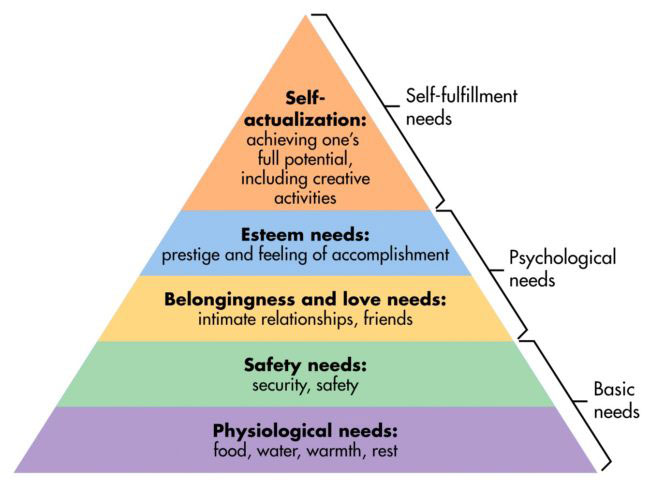
Abraham Maslow’s pyramid of human needs demonstrates that higher needs can only be achieved after basic needs are met. Credit: aaron- burke.net
Another famous pyramid is Abraham Maslow’s hierarchy of human needs. His theory, proposed in 1943, took the form of a pyramid, where the lowest rank was basic needs, and the highest was philosophical needs. The philosophical needs could not be attained if the more prosaic concerns had not already been met. The alphabet is a ranking of those prosaic concerns; it’s not organized as one might in the 21st century, but, instead, as a person living on Maslow’s lowest level might. The alphabet is about death and food and sex because written language originated when death and food and sex dictated the bulk of life.
A form of “Z” came in at number seven in the proto-alphabet, and it was a weapon (sometimes it looked like capital “I.”) “Z” and “7” and “I” all look similar. If you were going to defend yourself, slashing like Zorro with some type of sharpened stick would be how you would fend off an animal, including members of another tribe (and perhaps you would gain a new sense of identity after you had defended yourself, which could explain why this looks like “I”).

The beginning of “oxen” is “ag” in ancient Greek. Sound familiar? Ag vs. ox. Once the idea of “angle” or “angel” is introduced, however, the n sound gets added even though the spelling remains the same. Capital “N” is the same shape as capital “Z,” just rotated. Could “N” have carried some of the same implication of defense as “Z”? No surprise that “Z” begins our words for animals—think “zoology”—ani-mal: animated bad thing. “Z” is at the low-rent end of the alphabet for a reason. “A” is the alpha male and animals he identifies with, and “Z” is the other end of the spectrum, down where “U,” “V,” and “W” are. Even comic strip writers understand the ranking system of the alphabet (see above).
Pinker argues in The Blank Slate, A Denial of Human Nature, “In the last two decades anthropologists have gathered data on life and death in pre-state societies rather than accepting the warm and fuzzy stereotypes.”58 The stereotype of the “Noble Savage” Pinker pins the upon the “European colonists’ discovery of indigenous peoples….It captures the belief that humans in their natural state are selfless, peaceable, and untroubled, and that blights such as greed, anxiety, and violence are the products of civilization.”59
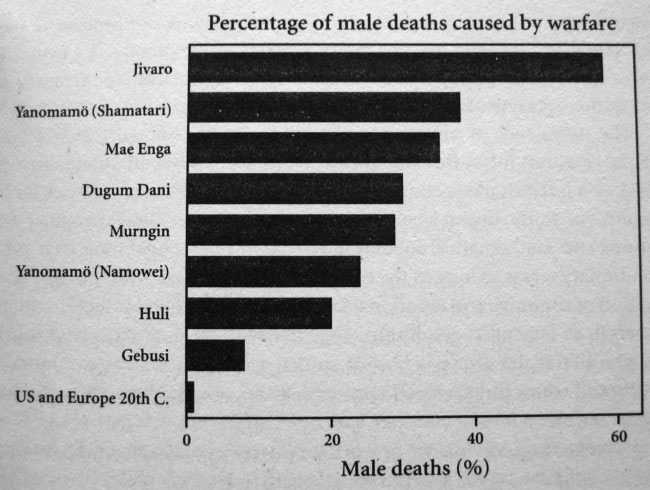
We’re actually more civilized now…who knew? Credit: The Blank Slate, Steven Pinker, page 57.
In contrast to this stereotype is the “Percentage of male deaths caused by warfare”60 in pre-state societies chart below. It would indicate the mankind is a violent specifies when uncivilized. As a mother, I can attest to this. Mothers have to civilize little brutes: use your words, hands to yourself, no poking. No one wants to hear that we are not born moral, but better to know so we can be conscious of the potential we have in us, both horrific and beatific. We evolved from animals. If we do not remember that fact, we are destined to continue to behave animalistically instead of evolving to something less motivated by brutal conquest. Examining the alphabet and language for the roots of our behavior is one way to know ourselves better.
- http://img2.travelblog.org/Photos/11829/46686/f/253224-More-Mustaba-Hieroglyph- ics-0.jpg
- http://www.absoluteastronomy.com/topics/Vulture
- Blackwell Encyclopedia of Writing Systems, Florian Coulmas, © 1999, page 139
- ibid, page 139
- http://www.astro.wisc.edu
- Wikipedia
- http://animaldiversity.ummz.umich.edu/site/accounts/information/Accipitridae.html
- http://www.encyclopedia.com/doc/1O29-GLOTTALSTOP.html
- The Language Instinct, Steven Pinker, page 362
- http://www.searchgodsword.org/lex/heb/view.cgi?number=07360
- The Barnhart Dictionary of Etymology
- Oxford History of Egypt, by Ian Shaw, page 374
- L.R. Berger and W.S. McGraw/note]
Primal man lived the Alfred Hitchcock movie The Birds. Back then birds could kill your children and certainly hurt you, as one tortured Prometheus (see right). This physical sharpness plus the mental sharpness of the eagle eye which could spot food from afar, caused mankind to both fear and revere this animal. “Members of the Accipitridae have eyesight that is four to eight times better than that of humans. This visual acuity allows them to spot prey from far away. For example, eagles are able to spot a vole or lizard from more than 400 m away.”13http://animaldiversity.ummz.umich.edu/site/accounts/information/Accipitridae.html
- Egyptian Grammar, page 4
- Egyptian Mythology, A guide to the Gods, Goddesses, and Traditions of Ancient Egypt, Geraldine Pinch, page 132
- ibid, page 132
- Reading in the Brain, Stanislaw Dehaene, © 2009, page 137
- ibid, page 133
- ibid, page 135
- Egyptian Mythology, Geraldine Pinch, pages 128-129
- The Oxford Dictionary of English Etymology
- (no longer existent link)
- Wikipedia
- Min pic from http://www.globalegyptianmuseum.org/images/glos/_250/min.jpg
- The Oxford History of Ancient Egypt, Ian Shaw, page 429
- The Alphabet versus the Goddess, Leonard Shlain, © 1998, page 11. Shlain acknowledges that this idea was put forth in The Second Sex by Simone de Beauvoir, who asserted that “the thrill of the hunt caused the divergence of human sexes by transforming the male.”
- Natural History of Rape, Randy Thornhill and Craig T. Palmer, page 13 (citing other sources)
- How Writing Came About, Denise Schmandt-Besserat, © 2006, page 1
- http://www.touregypt.net/featurestories/cattle.htm
- http://en.wikipedia.org/wiki/Venus_of_Laussel
- Nature; Vol. 455/25 September 2008/doi:10.1038/nature07180
- http://www.bbc.co.uk/history/ancient/egyptians/
- http://www.archaeowiki.org/Serabit_el-Khadim
- http://www.bbc.co.uk/history/ancient/egyptians/gods_gallery_07.shtml
- Dictionary of Word Roots and Combining Forms, Donald J. Borror, page 69
- http://www.wordinfo.info/words/index/info/view_unit/3136
- ibid
- http://www.newworldencyclopedia.org/entry/Oxyrhynchus
- © 2007 John P. Sullivan; http://tolweb.org/tree/ToLimages/mormyrids.jpg
- wiki.answers.com/Q/What_is_the_strongest_geometric_shape
- Principles of Biochemistry, Albert L. Lenninger, David Lee Nelson, Michael M. Cox,
©2004 - Wikipedia
- The Oxford History of Ancient Egypt, Ian Shaw, page 70
- Wikipedia
- Reading in the Brain, Stanislas Dehaene, page 153
- Reading in the Brain, Stanislas Dehaene, page 154
- http://www.civilization.ca/cmc/exhibitions/civil/egypt/egcr05e.shtml
- “Akh,” Alex Hopson, http://www.pantheon.org/articles/a/akh.html
- Egyptian Mythology, Geraldine Pinch, © 2002
- The Oxford History of Ancient Egypt, Ian Shaw, page 31
- http://www.online-dictionary.biz/latin/english/meaning/acutus
- Page 31
- http://discovermagazine.com/2009/jan/089
- The Oxford History of Ancient Egypt, Ian Shaw, page 34
- Oxford History of Egypt, Ian Shaw, page 68
- The Etymologies of Isidore of Seville, translated by Barney, Lewis, Beach, Berghof, page 94
- The Blank Slate, Steven Pinker, page 56
- ibid, page 6
- ibid, page 57
